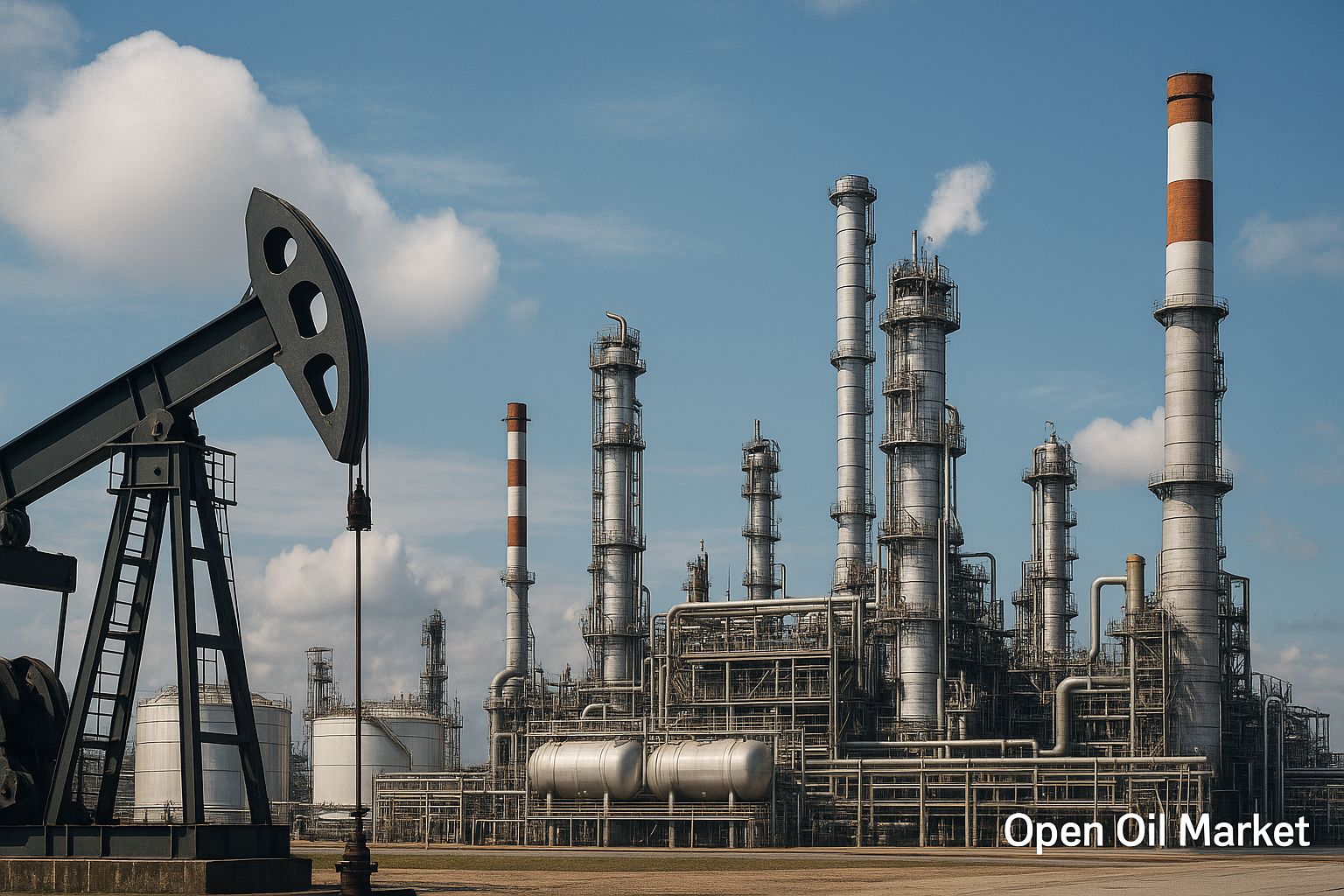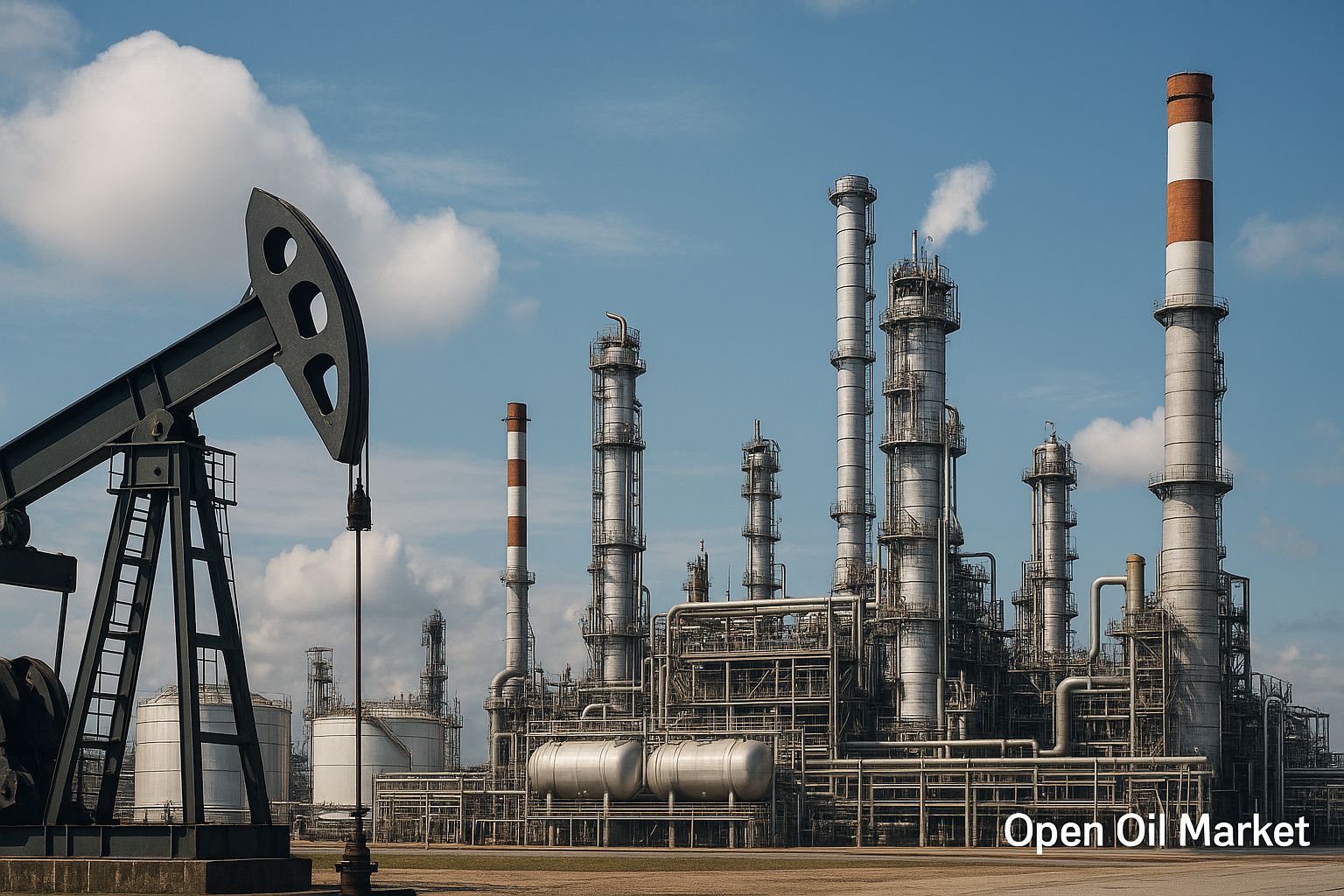
Current News in the Russian Energy Sector as of August 22, 2025: Stabilization of Fuel Prices, Trends in Oil and Gas, Coal and Electricity Situation, Government Measures in the Fuel Market, and Renewable Energy Development
The agenda of the energy sector on August 22, 2025, is marked by relative calm on the foreign policy front and active domestic measures aimed at stabilizing fuel prices. Following the meeting between the Presidents of Russia and the USA in mid-August, dialogue continues without new sanctions, providing markets with a breather and instilling cautious optimism among investors and industry stakeholders.
Oil prices remain relatively stable, with the North Sea benchmark Brent hovering around $67 per barrel, and U.S. WTI around $63. These levels are approximately 10% lower than a year ago, reflecting a gradual normalization of the market following price peaks in 2022–2023. The European gas market is also exhibiting calmness, with underground gas storage in the EU nearly full ahead of winter, keeping prices at a moderate level (around $400 per thousand cubic meters).
Meanwhile, the global energy transition is gaining momentum, with new records for electricity generation from renewable sources being reported worldwide. However, for the reliability of energy systems, countries cannot yet fully abandon traditional resources: oil, gas, and coal. In Russia, after an unprecedented spike in gasoline and diesel prices in early August, emergency government measures began to cool down the domestic fuel market. The supply of petroleum products is gradually stabilizing. Below is a detailed overview of key events and trends in the segments of oil, gas, electricity generation, and raw materials markets as of the current date.
Oil Market: Increased Production and Weak Demand Keep Prices Below $70
Global oil prices are demonstrating relative stability amid a combination of conflicting factors. Brent quotes stand around $67 per barrel, while WTI is in the range of $62–64. This is roughly 10% below last year's levels, reflecting a gradual market correction following the energy crisis of 2022–2023. A number of key factors are influencing price dynamics:
- OPEC+ Production Increase. The oil alliance continues to steadily increase supply in the global market. By September 2025, the total production quota for agreement participants will rise by approximately 547,000 barrels per day, effectively lifting the remaining voluntary restrictions from the previous year. Since spring, OPEC+ countries have already restored a significant part of the previously withdrawn oil to the market, leading to an increase in global inventories of crude and petroleum products.
- Slowing Demand Growth. Global oil demand is increasing at a more restrained pace. The International Energy Agency (IEA) projects an increase of around 0.7 million barrels per day in 2025 (for comparison, in 2023 it was over +2.5 million barrels per day). OPEC's forecast is also moderate, at about +1.3 million barrels per day. Reasons for this include a weakening global economy, the effect of high prices in previous years incentivizing energy conservation, and slowing industrial growth in China, reducing appetite from the second-largest oil consumer.
- Geopolitical Uncertainty. The market is pricing in conflicting risks associated with sanction-related confrontations. On one hand, the absence of new U.S. sanctions following the August summit in Alaska has reduced traders' anxiety: market participants hope that tensions will not escalate temporarily. On the other hand, the European Union is concurrently discussing yet another, already 19th package of restrictions against Russia, which serves as a reminder of the ongoing uncertainty. As a result, oil quotes fluctuate within a narrow range, lacking momentum for either a rise or a fall.
The combination of these factors maintains a situation close to a surplus in the oil market: supply slightly exceeds demand, keeping prices at a relatively low level. Brent is confidently trading below last year's figures, and several analysts believe that if current trends persist, the average price of this grade may drop to the range of $50–55 per barrel in 2026.
Gas Market: Europe Prepares for Winter with Nearly Full Storage
In the gas market, the main focus is on Europe, which is confidently preparing for the upcoming heating season. EU countries are rapidly injecting gas into underground storage, and the overall level of their fill has already exceeded 90% of maximum capacity. Such a high volume of reserves provides a strong cushion ahead of winter and prevents fuel prices from rising. Exchange gas prices at the TTF hub remain around 33–34 euros per MWh (approximately $400 per 1000 cubic meters), which is significantly lower than the peak values during the crisis of 2022.
Europe has managed to significantly diversify its sources of supply over the past year, increasing imports of liquefied natural gas (LNG) and reducing dependence on pipeline gas from Russia, thereby mitigating the impact of geopolitical factors. Even in the event of a harsh winter, such high starting reserves allow for expectations that shortages and extreme price spikes can be avoided.
International Politics: Sanctions Pause Supports Cautious Dialogue
External factors continue to impact the energy sector, although by the end of summer a certain easing has become apparent. Following the negotiations between the Presidents of Russia and the USA on August 15 in Anchorage, Alaska, the parties have maintained contact, and Washington has refrained from imposing new restrictive measures. U.S. President Donald Trump stated he does not plan to introduce additional sanctions against Russia in the near term — this has raised hopes for a pause in sanctions pressure.
However, the European Union is concurrently working on a new package of measures against the Russian energy sector, including possible price caps and equipment supply bans. Thus, the current breather may turn out to be temporary if the geopolitical situation escalates again. Meanwhile, the ongoing dialogue between Moscow and the West has slightly reduced the "risk premium" in energy resource prices and allowed markets to focus on fundamental supply and demand indicators.
Asia: India and China – Balancing Increased Imports with Domestic Production Growth
The two largest Asian energy consumers, India and China, continue to play a key role in the global market, balancing increased fuel imports with the development of their domestic production:
- India. Confronted with sanctions pressure, New Delhi has made it clear that it does not intend to sharply reduce purchases of Russian oil and gas, given their crucial role for national energy security. Indian importers have secured favorable terms: Russian Urals oil is sold to them at about $5 cheaper than the benchmark Brent, in order to maintain this strategically important market. As a result, India continues to actively purchase Russian oil and petroleum products on preferential terms, meeting rising demand. At the same time, the country’s leadership aims to reduce dependence on external supplies in the long term. On August 15, India’s Independence Day, Prime Minister Narendra Modi announced the launch of a national program for developing deepwater oil and gas fields. The state company ONGC has already begun drilling ultra-deep wells (up to 5 km) in the Andaman Sea, and the first results are considered promising. This "deepwater mission" is expected to uncover new hydrocarbon reserves and bring India closer to its goal of energy independence.
- China. The largest economy in Asia is increasing both imports and domestic production of energy resources. Chinese companies remain the leading buyers of Russian oil and liquefied gas as Beijing has not joined the Western sanctions and benefits from favorable pricing discounts. According to customs statistics, in 2024, China imported about 212.8 million tons of oil and 246.4 billion cubic meters of natural gas (an increase of +1.8% and +6.2% compared to the previous year, respectively). Import growth continued in 2025, although at a more moderate pace due to the high baseline. Simultaneously, China is stimulating the development of its own fields: from January to July 2025, national companies extracted about 126.6 million tons of oil (+1.3% year-on-year) and 152.5 billion cubic meters of gas (+6% year-on-year). Growth in domestic production partially offsets increased demand but does not eliminate dependence on external supplies. Analysts estimate that in the coming years, China will import at least 70% of its oil consumption and about 40% of its gas, despite significant investments in its own resource base.
Thus, India and China continue to balance affordable imports of energy carriers and the development of domestic production. Their course towards ensuring energy security, on one hand, and profitable external purchases, on the other, will continue to significantly influence the state of demand and prices in the global oil and gas market.
Energy Transition: Renewable Energy Records and the Need for Balance with Traditional Energy
The global shift to clean energy is rapidly accelerating, albeit requiring a balance with traditional generation. In Europe, the total electricity generation from solar and wind sources exceeded that from coal and gas for the first time in 2024. This trend continues in 2025: the commissioning of new renewable energy capacities increases the share of "green" electricity, while coal’s role in the EU’s energy balance is gradually decreasing (after a temporary increase during the 2022–2023 crisis). In the U.S., renewable energy has also reached record levels — at the beginning of 2025, more than 30% of all generation came from renewables, and the total volume of wind and solar energy production exceeded that from coal power plants for the first time. China, as the world leader in installed renewable energy capacity, annually adds tens of gigawatts of new solar panels and wind turbines, continuously updating its own "green" records.
However, energy systems worldwide still cannot do without traditional sources — primarily oil, gas, and coal — to ensure stability. The increase in the share of solar and wind creates serious challenges for balancing energy grids: during hours of low sunlight or wind, the power shortfall must be compensated by gas and, at times, coal-fired power plants. For instance, during the winter of 2024/25, several European countries had to temporarily return coal-fired power plants to operation during prolonged windless periods, despite the environmental costs. To improve the reliability of energy supplies, authorities and companies are investing in energy storage systems (industrial batteries, pumped storage plants) and smart grids capable of flexibly responding to fluctuations in generation. According to IEA forecasts, by 2026–2027, renewable sources could become the top producers of electricity worldwide, finally surpassing coal. However, in the coming years, there will be a continued need to keep some traditional capacities in reserve as a safety net. Thus, the energy transition is reaching new heights but requires a delicate balance between green technologies and conventional fuel resources.
Coal: High Demand Remains Amid Moderated Prices
Despite the climate agenda, the global coal market is still characterized by high demand and remains an essential part of the global energy balance. Coal consumption is particularly high in the Asia-Pacific region, where economic growth and electricity needs support the intensive use of this fuel. China, the world's largest consumer and producer of coal, is burning coal at levels close to record highs in 2025. Chinese mines extract over 4 billion tons of coal annually, and this volume barely suffices during peak demand periods (for example, in hot summer months when air conditioning is widely used). India, with significant reserves, is also increasing electricity generation from coal: over 70% of the country's electricity is produced at coal-fired power plants, and absolute consumption is rising along with the economy. Other developing countries in Asia (Indonesia, Vietnam, Bangladesh, etc.) are implementing new coal power plant projects to ensure affordable energy for their regions.
Global coal prices have stabilized at relatively moderate levels after sharp fluctuations in recent years, which supports the attractiveness of this resource. Many countries, especially in Asia and Africa, still view coal as a reliable and inexpensive source of energy for industrialization. Meanwhile, developed economies are rapidly reducing coal use to meet environmental commitments. Nevertheless, on a global scale, coal demand is expected to remain high in the coming years. As such, the coal industry maintains stability due to sustained demand despite the rapid development of renewable energy in the energy sector.
The Russian Oil Products Market: Prices Begin to Stabilize Under the Influence of Measures
After a sharp price spike in early August, the situation in the Russian oil products market is gradually improving. In the first weeks of the month, exchange prices for gasoline and diesel fuel repeatedly set historical highs, raising concerns among consumers and authorities. By mid-August, the government quickly implemented a series of actions to normalize the situation:
- Increased Supply on the Exchange. By order of Deputy Prime Minister Alexander Novak, oil companies are ramping up the volumes of fuel sold through exchange trading. The sales norm for gasoline at the St. Petersburg International Commodity Exchange has been increased from 15% to 17% of production volumes, enhancing resource availability in the domestic market.
- Export Restrictions on Fuel. The possibility of a temporary complete ban on the export of motor gasoline is being considered to redirect maximum volumes to domestic needs. This step is discussed by authorities and market participants as an emergency measure to saturate the Russian market with fuel and reduce prices.
- Adjustment of the Dampening Mechanism. The Ministry of Finance and the State Duma are working on adjusting the parameters of the dampening mechanism - the subsidy system for oil refiners. This involves increasing the volume of compensation or expanding the price corridor to support refinery margins and reduce incentives for oil producers to raise prices.
- Accelerated Repairs of Refineries. The Ministry of Energy has expedited the completion of unscheduled repairs at several oil refining plants caused by accidents and drone attacks. Reserve capacities have been brought back online, increasing oil processing and fuel production at these refineries. The ministry states that in the coming weeks, gasoline production will return to normal levels, eliminating supply shortages — one of the causes of the recent price rally.
Thanks to these measures, signs of stabilization began to appear in the market in the second half of August. Following peak values on August 21, exchange fuel quotes started to decline: Regular-92 gasoline dropped in price by about 2% on August 22, while Premium-95 showed a comparable decrease. Retail prices at gas stations remain relatively stable, as authorities do not allow a full transfer of fuel price increases to end consumers.
"The lower the volume of subsidies, the lower the refinery margin. According to the latest data, the net profit of Russian refineries decreased by more than 60% in the first five months of 2025. Thus, the rise in exchange prices partially compensates for these losses," noted Sergey Tereshkin in a comment for "Rossiyskaya Gazeta."
Experts predict that a real decline in wholesale gasoline prices will not begin until mid-September, when refinery repairs are completed and seasonal demand subsides. Nevertheless, even now, the wholesale fuel market has stopped rising rapidly, indicating the effectiveness of the measures taken. Industry participants expect that by autumn the situation will stabilize fully, and prices for oil products will return to a more predictable dynamic.




